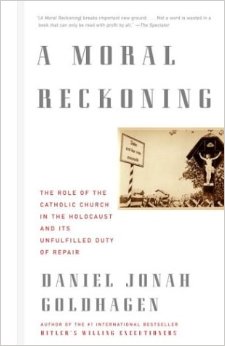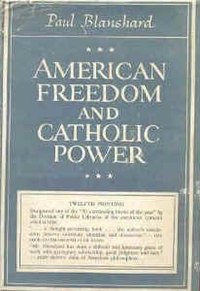The relations between the Catholic Church and the state have been constantly evolving with various forms of government, some of them controversial in retrospect. In its history, the Church has had to deal with various concepts and systems of governance, from the Roman Empire to the medieval divine right of kings, from nineteenth- and twentieth-century concepts of democracy and pluralism to the appearance of left- and right-wing dictatorial regimes. The Second Vatican Council's decree Dignitatis humanae stated that religious freedom is a civil right that should be recognized in constitutional law.

The Catholic League for Religious and Civil Rights, often shortened to the Catholic League, is an American Catholic organization whose stated purpose is to "defend the right of Catholics – lay and clergy alike – to participate in American public life without defamation or discrimination." The Catholic League states that it is "motivated by the letter and the spirit of the First Amendment ... to safeguard both the religious freedom rights and the free speech rights of Catholics whenever and wherever they are threatened." According to the Encyclopedia of American Religion and Politics, the league "is regarded by many as the preeminent organization representing the views of American lay Catholics."

Beacon Press is an American left-wing non-profit book publisher. Founded in 1854 by the American Unitarian Association, it is currently a department of the Unitarian Universalist Association. It is known for publishing authors such as James Baldwin, Mary Oliver, Martin Luther King Jr., and Viktor Frankl, as well as The Pentagon Papers.

Anti-Catholicism is hostility towards Catholics and/or opposition to the Catholic Church, its clergy, and/or its adherents. At various points after the Reformation, some majority Protestant states, including England, Prussia, Scotland, and the United States, turned anti-Catholicism, opposition to the Pope (anti-Papalism), mockery of Catholic rituals, and opposition to Catholic adherents into major political themes and policies of religious persecution. The anti-Catholic sentiment which resulted from this trend frequently led to religious discrimination against Catholic communities and individuals and it occasionally led to the religious persecution of them Historian John Wolffe identifies four types of anti-Catholicism: constitutional-national, theological, popular and socio-cultural.
William Anthony Donohue is an American Roman Catholic layman who has been president of the Catholic League in the United States since 1993.

Hitler's Pope is a book published in 1999 by the British journalist and author John Cornwell that examines the actions of Eugenio Pacelli, who became Pope Pius XII, before and during the Nazi era, and explores the charge that he assisted in the legitimization of Adolf Hitler's Nazi regime in Germany, through the pursuit of a Reichskonkordat in 1933. The book is critical of Pius' conduct during the Second World War, arguing that he did not do enough, or speak out enough, against the Holocaust. Cornwell argues that Pius's entire career as the nuncio to Germany, Cardinal Secretary of State, and Pope, was characterized by a desire to increase and centralize the power of the Papacy, and that he subordinated opposition to the Nazis to that goal. He further argues that Pius was antisemitic and that this stance prevented him from caring about the European Jews.

Anti-Protestantism is bias, hatred or distrust against some or all branches of Protestantism and/or its followers.

"Every Sperm Is Sacred" is a musical sketch from the film Monty Python's The Meaning of Life. A satire of Catholic teachings on reproduction that forbid masturbation and contraception, the song was released on the album Monty Python Sings and was nominated for a BAFTA Music Award for Best Original Song in a Film in 1983.
Paul Beecher Blanshard was an American author, assistant editor of The Nation magazine, lawyer, socialist, secular humanist, and from 1949 an outspoken critic of Catholicism.
Philip Jenkins is a professor of history at Baylor University in the United States, and co-director for Baylor's Program on Historical Studies of Religion in the Institute for Studies of Religion. He is also the Edwin Erle Sparks Professor of Humanities Emeritus at Pennsylvania State University (PSU). He was professor and a distinguished professor of history and religious studies at the same institution; and also assistant, associate and then full professor of criminal justice and American studies at PSU, 1980–93.
Members of the Catholic Church have been active in the elections of the United States since the mid 19th century. The United States has never had religious parties. There has never been an American Catholic religious party, either local, state or national.

In the United States, freedom of religion is a constitutionally protected right provided in the religion clauses of the First Amendment. As stated in the Bill of Rights: "Congress shall make no law respecting an establishment of religion, or prohibiting the free exercise thereof...". Freedom of religion is linked to the countervailing principle of separation of church and state, a concept advocated by Colonial founders such as Dr. John Clarke, Roger Williams, William Penn, and later Founding Fathers such as James Madison and Thomas Jefferson.
Anti-Catholicism in the United States concerns the anti-Catholic attitudes first brought to the Thirteen Colonies by Protestant European settlers, composed mostly of English Puritans, during the British colonization of North America. Two types of anti-Catholic rhetoric existed in colonial society and they continued to exist during the following centuries. The first type, derived from the theological heritage of the Protestant Reformation and the European wars of religion, consisted of the biblical Anti-Christ and the Whore of Babylon variety and it dominated anti-Catholic thought until the late 17th century. The second type was a variety partially derived from xenophobic, ethnocentric, nativist, and racist sentiments and distrust of increasing waves of Roman Catholic immigrants, particularly from Ireland, Italy, Poland, and Mexico. It usually focused on the pope's control of bishops, priests, and deacons.

A Moral Reckoning: The Role of the Catholic Church in the Holocaust and Its Unfulfilled Duty of Repair is a 2003 book by the political scientist Daniel Jonah Goldhagen, previously the author of Hitler's Willing Executioners (1996). Goldhagen examines the Roman Catholic Church's role in the Holocaust and offers a review of scholarship in English addressing what he argues is antisemitism throughout the history of the Church, which he claims contributed substantially to the persecution of the Jews during World War II.
The movement for compulsory public education in the United States began in the early 1920s. It started with the Smith-Towner bill, a bill that would eventually establish the National Education Association and provide federal funds to public schools. Eventually it became the movement to mandate public schooling and dissolve parochial and other private schools. The movement focused on the public's fear of immigrants and the need to Americanize; it had anti-Catholic overtones and found support from groups like the Ku Klux Klan.

The New Anti-Catholicism: The Last Acceptable Prejudice is a book written by Philip Jenkins, Distinguished Professor of History and Religious studies at Pennsylvania State University, dealing with contemporary anti-Catholic bigotry, particularly in the United States.

Anti-Catholicism in the United Kingdom dates back to Roman times. Attacks on the Church from a Protestant angle mostly began with the English and Irish Reformations which were launched by King Henry VIII and the Scottish Reformation which was led by John Knox. Within England, the Act of Supremacy 1534 declared the English crown to be "the only supreme head on earth of the Church in England" in place of the Pope. Any act of allegiance to the latter was considered treasonous because the papacy claimed both spiritual and political power over its followers. Ireland was brought under direct English control starting in 1536 during the Tudor conquest of Ireland. The Scottish Reformation in 1560 abolished Catholic ecclesiastical structures and rendered Catholic practice illegal in Scotland. Today, anti-Catholicism remains common in the United Kingdom, with particular relevance in Scotland and Northern Ireland.
The Catholic Church has been criticised in fiction, such as literature, film and television. Polemics have also been written on the Church and its practices. Some examples are the anti-Catholic stereotypes that filled Gothic fiction of Anglican England, the films of Luis Buñuel who took issue with the Church in Spain, the humor of some US television pundits like Rosie O'Donnell, and the rhetoric of some fundamentalist preachers.
In 1800 the Catholics were a small minority everywhere except Maryland. Immigration from Ireland and Germay gave them millions of adherents from the 1840s to the 1880s. Then came millions more from Italy, Poland and Eastern Europe, as well as French Canada. Large numbers of priests and nuns came from Ireland and France. The Irish soon dominated the clergy church, with a great majority of bishops by 1900. As the immigrants arrived new parishes and diocese were created. Rebuffed in efforts to obtain government funds for schools, the Catholics set up a parochial school system largely staffed with nuns. It reached about a third of the children. They also set up colleges. There were few Catholics in the South, apart from Louisiana. However they were well represented in the nation's cities, mill towns and mining centers. Anti-Catholic politics flared briefly in the 1850s, but the Catholic voters surged into the Democratic Party and Irish Catholic politicians played increasingly doiminant roles in Democratic machines in Boston, New York, and other major cities. Devotional practices included daily rosary prayers, regular attendance at Sunday Mass, and special roles for devotion to the Blessed Virgin Mary and favorite saints.
The term "recovering Catholic" is used by some former practicing Catholics to describe their religious status. The use of the term implies that the person considers their former Catholicism to have been a negative influence on their life, one to be "recovered" from. The term first came into use in the 1980s.









